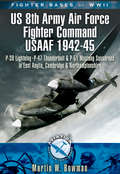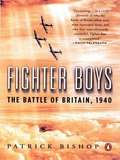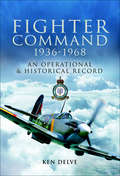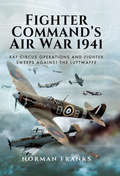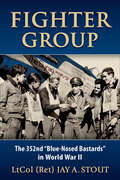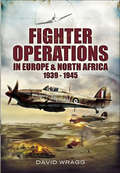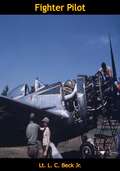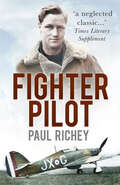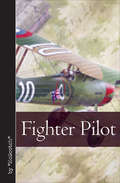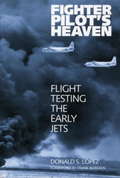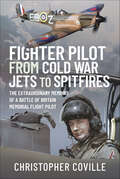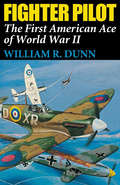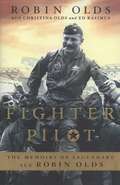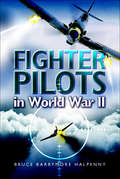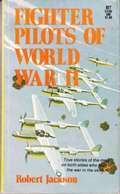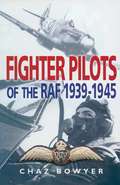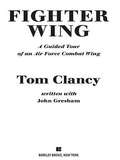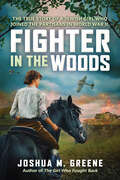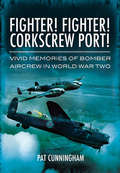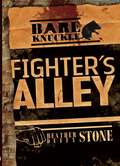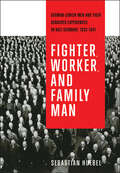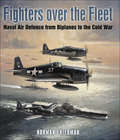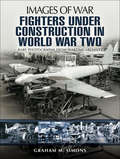- Table View
- List View
Fighter Bases of WW II US 8th Army Air Force Fighter Command USAAF, 1943–45: P-38 Lightning, P-47 Thunderbolt and P-51 Mustang Squadrons in East Anglia, Cambridgeshire and Northamptonshire
by Martin W. BowmanThis book covers the bases used during the Second World War by the American fighter units that flew in support of the 8th Air Forces heavy bomber forces.The long-range Lightnings, Thunderbolts and Mustangs escorted the Mighty Eighths Flying Fortresses and Liberators on their deep penetration raids into occupied Europe and Germany. Fighter cover was vital, since the USAAF flew daylight raids and in the early months the number of US aircraft lost to the defending Luftwuffe fighters was unacceptably high.The airfields included are Bodney, Bottisham, Boxted, Debden, Duxford, East Wretham, Fowlmere, Halesworth, Honington, Horsham St. Faith, Kings Cliffe, Leiston, Martlesham Heath, Raydon, Steeple Morden, Wattisham and Wormingford.This book looks at the history and personalities associated with each base, what remains today and explores the favorite local wartime haunts where aircrew and ground crew would have sought well-deserved entertainment and relaxation. Other museums and places that are relevant will also be described and general directions on how to get them included.
Fighter Boys
by Patrick BishopThe summer of 1940 was supposed to be the beginning of the end of Britain. Europe had fallen to Hitler's storm troops with terrifying speed, and once the Royal Air Force was destroyed, Britain was next. But that was precisely where the Nazis stumbled. For 123 days, while Herman Goering sent wave after wave of Luftwaffe fighters to rain down fire on Britain, three thousand young RAF airmen fought back with a ferocity and agility that stunned the world. Now in this riveting book, military historian and journalist Patrick Bishop presents the first account of this critical campaign told from the perspective of the pilots themselves. Drawing on interviews with scores of surviving pilots as well as diaries and letters never seen before, Bishop re-creates with astonishing intimacy and clarity this excruciating, exhilarating war of nerves. In their own words, the pilots describe what it felt like when an engine exploded, a parachute failed to open, a swarm of Messerschmitts surrounded their plane, a bomb fell on their home village, a comrade's plane "went in" (their bland term for a high speed crash into the ground). Had the RAF failed, a successful German invasion would have been inevitable-and the pilots knew it. Under unimaginable pressure, these nineteen- and twenty-year-old heroes brought down the world's most powerful air force and saved their nation-and the free world.
Fighter Command, 1936–1968: An Operational & Historical Record
by Ken DelveThis is a comprehensive reference to the structure, operation, aircraft and men of Fighter Command from its formation in 1936 to 1968 when it became part of Strike Command. It includes descriptions of many notable defensive and offensive campaigns, the many types of aircraft used, weapons and airfields. The main sections of the book include a general historical introduction and overview, operations, operational groups, aircrew training and technical details of each aircraft type. Lengthy Annexes cover personnel, the squadrons in World War II, orders of battle for each wartime year, maps of airfield locations and numbers of enemy aircraft downed.
Fighter Commands Air War, 1941: RAF Circus Operations and Fighter Sweeps Against the Luftwaffe
by Norman FranksAn extensive history of the Royal Air Force&’s Circus offensive against Nazi Germany in World War II, by the author of Jasta Boelcke. Following the Battle of Britain, the RAF started taking the air war to the Germans. A small number of bombers, escorted by large numbers of fighters, tried to force the Luftwaffe into battle. Much air combat ensued, but it was not until Germany invaded Russia in June, 1941, that operations were stepped up in an effort to take pressure off Stalin&’s Russian Front. Two major German fighter groups, JG26 and JG2, were, however, more than able to contain the RAF&’s operations, generally only intercepting when conditions were in their favor. As author Norman Franks describes, over-claiming combat victories by pilots of both sides is amazing, and several of the top aces had inflated scores. Fighter Command, however, lost massively even though they believed they were inflicting equal, if not better, losses on the Luftwaffe. This battle of attrition was virtually a reverse of the 1940 battles over England, and pilots who had to bail out over France, were lost completely. The book covers the 100+ Circus operations and their accompanying fighter sweeps in detail, while also mentioning lesser operations where the RAF were concerned. The tactics employed by both sides are examined and show how each fighter force quickly adapted to changing conditions tempered by experiences gained in air combat.
Fighter Group: The 352nd "Blue-Nosed Bastards" in World War II
by Jay A Stout Lt.From a historian, retired fighter pilot, and combat aviation specialist, &“the finest book yet written about the air war over Europe during World War II.&” (Air & Space, Smithsonian magazine ) As described by award-winning author Jay A. Stout, the 352nd Fighter Group was one of the Eighth Air Force's most successful fighter units and counted history's two top-scoring P-51 aces among its ranks. This book—the most comprehensive work ever to cover the actions of a single USAAF fighter unit—details the air actions of not only the group's notable aces, but also the rank-and-file fliers who carried the bulk of the load. It describes the 352nd&’s activities from its formation at the close of 1942, its movement to England and its combat operations flying P-47s and P-51s against the Third Reich. Although the book covers the units actions as a whole, it also follows several pilots in detail. Rich descriptions of tactics and equipment, personal reflections, letters home, amusing anecdotes and, of course, detailed descriptions of air combat. Not simply an award-winning historian, Stout draws from his own combat experience as a fighter pilot to make these discussions credible, interesting and real. Winner of the San Diego Book Award for History. &“Stout&’s crisp, concise writing powers a narrative that highlights a collection of aviators who destroyed more than 700 German aircraft. The book is certain to take its place with other memorable accounts of European combat.&” —John F. Wukovits, author of Black Sheep
Fighter Operations in Europe and North Africa, 1939–1945
by David WraggFighter Operations in Europe and North Africa 1939–1945 tells the story of Allied and German fighter pilots in Europe, over the Mediterranean and in North Africa during the Second World War. The book starts with the early skirmishes as each side tested the others defenses, moves through the Battle of Britain and then the Blitz, when the emphasis switched from single-engined day fighters to twin-engined night fighters, while increasingly fighters were used to sweep over enemy air fields and lines of communication in occupied France. This overlapped with the need to provide air cover for the besieged island fortress of Malta by day and by night, as well as defensive operations against Axis forces in Crete and North Africa, but as the balance of power changed in North Africa, the Desert Air Force was formed incorporating elements from many Allied air forces and the emphasis moved to offensive operations in support of ground forces. The invasions of Italy and the South of France also called for fighter cover, initially by carrier-based aircraft. The lessons learnt in North Africa were put to good use by the 2nd Allied Tactical Air Force, which accompanied the advancing allied armies towards and eventually into Germany, achieving all important air supremacy which was a major factor in the Allied victory. The book also covers Luftwaffe fighter pilots as they sought to stop the RAF by night and the USAAF by day, against increasingly overwhelming odds.
Fighter Pilot
by Lt. L. C. Beck Jr.Fighter Pilot is the incredible story of a World War II fighter pilot, 1st Lieutenant Levitt Beck, Jr., who was shot down in German-occupied France and hidden by members of the French underground. There he wrote this story of his life practically up until the moment he was discovered. He perished in Buchenwald concentration camp, but his manuscript was delivered to his parents after the war, who took on the responsibility of seeing it published posthumously in 1946.Lt. Beck was shot down near Havelu, Eure-et-Loir, France on 29 June 1944 on an Armed Reconnaissance mission to the Mantes-la-Jolie/Gassicourt area. Although he initially managed to evade capture, he was eventually taken prisoner and, together with more than 167 other Allied airmen, was on a convoy that left Paris on August 18, 1944. He was interned at the Buchenwald concentration camp on August 20, 1944, where he became ill from maltreatment and undernourishment and died of “Lungentuberculosis” (phthisis; pulmonary consumption) in the camp hospital on October 31, 1944, aged 24.His remains were never found and he continues to be listed as MIA (Missing in Action). He is believed to have been cremated in Buchenwald the day following his death. He memorialized at the Luxembourg American Cemetery, Luxembourg City, Great-Duchy of Luxemburg.
Fighter Pilot
by Paul RicheyOne of ‘The 30 Best Travel and Adventure Books of All Time’, as selected by Gear Patrol, Winner 2015 US Travel and Adventure website. Fighter Pilot was written from the immediate and unfettered personal journal that 23-year-old Flying Officer Paul Richey began on the day he and No. 1 Squadron landed their Hawker Hurricanes on a grass airfield in France. Originally published in September 1941, it was the first such account of air combat against the Luftwaffe in France in the Second World War, and it struck an immediate chord with a British public enthralled by the exploits of its young airmen. It is the story of a highly skilled group of young volunteer fighter pilots who patrolled, fl ew and fought at up to 30,000 feet in unheated cockpits, without radar and often from makeshift airfields, and who were finally confronted by the overwhelming might of Hitler’s Blitzkreig. It tells how this remarkable squadron adapted its tactics, its aircraft and itself to achieve a brilliant record of combat victories – in spite of the most extreme and testing circumstances. All the thrills, adrenalin rushes and the sheer terror of dog-fighting are here: simply, accurately and movingly described by a young airman discovering for himself the deadly nature of the combat in which he is engaged.
Fighter Pilot (Vintage Aviation Library)
by "McScotch" Mannock&“McScotch&” himself describes his book and pays tribute to a colleague in this note, which appears at the front of the volume: &“This book consists of the reminiscences of an ordinary fighter pilot of the R.F.C. who had the privilege of serving in one of the leading Fighter Squadrons and who had the honor of being the friend of the supreme fighter of all the Air Forces, that indomitable and lovable patriot, &‘MICK&’ MANNOCK, V.C., D.S.O., M.C.&” Available records and publications show &“McScotch&” himself as a fighter pilot with 40 Squadron, holding the rank of lieutenant and then captain. He is credited with 12 kills of German opponents. This is a detailed and exciting account of squadron life and shows the bravery and true comradeship of these flyers.
Fighter Pilot's Heaven: Flight Testing the Early Jets
by Donald S. LopezFighter Pilot's Heaven presents the dramatic inside story of the American military's transition into the jet age, as told by a flyer whose life depended on its success. With colorful anecdotes about fellow pilots as well as precise technical information, Donald S. Lopez describes how it was to be "behind the stick" as a test pilot from 1945 to 1950, when the U.S. military was shifting from war to peacetime operations and from propeller to jet aircraft.An ace pilot who had served with Gen. Claire Chennault's Flying Tiger Fighter Group, Lopez was assigned at the close of World War II to the elite Proof Test Group of the Air Proving Ground Command. Located at Eglin Field (later Eglin Air Force Base) in Florida, the group determined the operational suitability of Air Force weapons systems and aircraft and tested the first operational jet, the P-80 Shooting Star. Jet fighters required new techniques, tactics, and weaponry. Lopez recounts historic test flights in the P-59, P-80, and P-84, among other planes, describing complex combat maneuvers, hair-raising landings in unusual positions, and disastrous crashes and near crashes. This memoir is peppered with lively accounts of many pilots and their colleagues, revealing how airmen coped with both exhilarating successes and sometimes tragic failures.
Fighter Pilot: The Extraordinary Memoirs of a Battle of Britain Memorial Flight Pilot
by Christopher CovilleA young boy sits in the back of a Chipmunk aircraft at RAF Woodvale, near Liverpool. He has never flown in anything before. As the power goes on and the little aeroplane soars into a clear blue sky, he decides at once that this is the only thing he wants to do in life: to be an RAF pilot. Fighter Pilot: From Cold War Jets to Spitfires tells the riveting story of how a boy from Liverpool, at the height of the Cold War, joined an RAF that was largely led by veterans of the Second World War. Christopher Coville arrived at the RAF College at Cranwell to find an environment shaped by English Public School traditions, but he made the grades needed to be streamed onto fighters, and went on to fly the Lightning, Phantom and Tornado F3 in the air defense role. Christopher eventually became station commander of RAF Coningsby and while in that role flew with the Battle of Britain Memorial Flight, becoming the only station commander to qualify on the Hurricane, Spitfire and Lancaster. He also qualified on helicopters and multi-engine aircraft and became responsible for the quality of the displays performed by the Red Arrows, flying with them regularly. Along the way, he steered the RAF’s biggest re-equipment programme since 1945 during a tour at the Ministry of defense and filling a challenging top NATO post during the wars in the Balkans. While this is a book about a young man from Liverpool who joined from grammar school and became a three-star Air Marshal, it is also, above all, a story written by a passionate aviator, whose affection for flying leaps out of every line, in a book which is full of excitement, deep knowledge of flying and affection for his fellow servicemen and women. But it is also a wonderful narrative about people, the great characters forged by military life, and honed by fear, exhilaration, and occasional tragedy. Fighter Pilot: From Cold War Jets to Spitfires is a unique perspective on aviation, written by a talented and dedicated pilot at the very top table of the RAF. This book culminates with his retirement, as the No.3 in the RAF, and being invited to have lunch with The Queen.
Fighter Pilot: The First American Ace of World War II
by William R. DunnThis WWII fighter pilot memoir recounts the author&’s many exploits as a flying ace during WWII in the Normandy invasions, the Battle for France and beyond. Born in Minneapolis in 1916, William R. Dunn decided to become a fighter pilot at the age of twelve. In 1939 he joined the Canadian Army and was soon transferred to the Royal Air Force. As part of the RAF&’s famous Eagle Squadron, Dunn was sent to Europe to fight in the Second World War. Flying Hawker Hurricanes and Supermarine Spitfires, he was the first Eagle Squadron pilot to shoot down an enemy aircraft. When he later transferred to the US Army Air Forces, he became the first American ace of the war. Lieutenant Colonel Dunn saw action in the Normandy invasion and in Patton's sweep across France. Twenty years later he fought again in Vietnam. In this lively memoir, Dunn keenly conveys the fighter pilot's experience of war—the tension of combat, the love of aircraft, the elation of victory, the boisterous comradeship and competition of the pilot brotherhood.
Fighter Pilot: The Memoirs of Legendary Ace Robin Olds
by Robin Olds Christina Olds Ed RasimusThe biography of American fighter pilot Robin Olds, who was a larger-than-life hero with a towering personality.
Fighter Pilots in World War II: True Stories of Frontline Air Combat
by Bruce Barrymore HalpennyThis is the story of Allied fighter pilots and the part they played in all the principal operational theatres of World War II. It also tells of life on the wartime airfield and how ground crew kept the aircraft ready for action either in the bitter cold of a Scottish winter or the sweltering heat of the North African desert. The book brings home the nervous strain caused by the constant readiness demanded by all those involved with fighter squadron combat and the intense comradeship created in each fighting unit.
Fighter Pilots of World War II
by Robert JacksonTo select fourteen fighter pilots from the hundreds who fought with distinction on all sides during World War II has been a difficult, not to say impertinent task. In the end, as representative of all the others, I selected those who, to my mind, showed certain individual characteristics that seemed to set them apart.
Fighter Pilots of the RAF, 1939–1945
by Chaz BowyerThe author has selected some twenty RAF fighter pilots of the Second World War, not only to give overdue recognition to their prowess and courage, but also to exemplify the wide diversity of the individual characters of those men whose war was fought from the cockpit of an RAF fighter. A few were familiar names but most received little or no public acclaim, being part of the silent majority which provided the real spine of the RAF's fighter effort throughout the conflict.
Fighter Wing: A Guided Tour of an Air Force Combat Wing (Tom Clancy's Military Referenc #3)
by Tom Clancy John GreshamNow, for the first time, an insider's look at an Air Force combat wing --the planes, the technology, and the people . . . with Tom Clancy as your guide. UPDATED WITH NEW MATERIALS AND PHOTOS!
Fighter in Velvet Gloves: Alaska Civil Rights Hero Elizabeth Peratrovich
by Annie Boochever Roy Peratrovich, Jr.“No Natives or Dogs Allowed,” blared the storefront sign at Elizabeth Peratrovich, then a young Alaska Native Tlingit. The sting of those words would stay with her all her life. Years later, after becoming a seasoned fighter for equality, she would deliver her own powerful message: one that helped change Alaska and the nation forever. In 1945, Peratrovich stood before the Alaska Territorial Legislative Session and gave a powerful speech about her childhood and her experiences being treated as a second-class citizen. Her heartfelt testimony led to the passing of the landmark Alaska Anti-Discrimination Act, America’s first civil rights legislation. Today, Alaska celebrates Elizabeth Peratrovich Day every February 16, and she will be honored on the gold one-dollar coin in 2020. Annie Boochever worked with Elizabeth’s eldest son, Roy Peratrovich Jr., to bring Elizabeth’s story to life in the first book written for young teens on this remarkable Alaska Native woman.
Fighter in the Woods: The True Story of a Jewish Girl who Joined the Partisans in World War II
by Joshua M. GreeneFrom award-winning author Joshua M. Greene (The Girl Who Fought Back; Signs of Survival) comes this remarkable true story of a Jewish girl in Nazi-occupied Poland who escaped near death to join -- and fight -- with the Soviet partisans in the woods. Scholastic Focus is the premier home of thoroughly researched, beautifully written, and thoughtfully designed works of narrative nonfiction aimed at middle-grade and young adult readers. These books help readers learn about the world in which they live and develop their critical thinking skills so that they may become dynamic citizens who are able to analyze and understand our past, participate in essential discussions about our present, and work to grow and build our future.The year was 1941, and Nazi Germany was bombing Poland. Celia Kassow, a young Jewish girl, knew she was in danger of being seized by the Nazis, so she ran to seek shelter at a Polish classmate's house. The classmate's response? "Get away from here, you dirty Jew."Celia and her family, like all the Jewish families in their town, were then imprisoned in a Nazi ghetto, facing daily starvation and torture. Most of Celia's family was murdered there, but a different Polish classmate of Celia's, a boy who had a crush on her, helped Celia escape to his family's farm, and eventually, into the woods to join the Soviet partisans.The partisans were resistance fighters who gathered in secret during WWII to fight back against the Axis powers by attacking German garrisons and blowing up trains. When Celia joined them, the other partisans -- mostly young men -- wanted to put her on kitchen duty, but Celia refused and asked to be put on patrol. She was given a horse, ammunition, and an assignment. Celia survived the war fighting with the partisans. After the war, she would go on to get married, have children, and immigrate to the United States, where she lived out her days assisting other immigrants and raising her family. Her true story, based on first-person testimony and vetted by Celia's son, is one of incredible bravery and grit in the face of unimaginable evil.
Fighter! Fighter! Corkscrew Port!: Vivid Memories of Bomber Aircrew in World War Two
by Pat CunninghamThe young men who flew with RAF Bomber Command in World War Two were a complex mixture of individuals but they all shared the gift of teamwork. A crew of seven may have comprised all non-commissioned men and some crews included commissioned officers but not always flying as pilots. The outstanding fact was that each man relied on every other member of his crew to return from each mission safely.This book contains ten intriguing reminiscences of bomber aircrew; some were pilots, others navigators, flight engineers, bomb-aimers or gunners. They flew as both commissioned or NCO airmen. Understandably, a common problem was that of coping with fear. Many former aircrew hold that anyone who claims to have felt no fear on operations is either lying or has allowed the years to blank out that fear. But there are a few who do maintain that they never felt afraid. For the majority, though, handling fear was something to be worked out by the individual. Some hit the bottle, others womanized to excess; others tightened the gut and bit the lip; or drew the curtain and focused upon the plotting table or the wireless set. The passing years may have silvered what hair remains, dulled the eye that formerly registered on the merest speck; lent a quiver to the hand that once controlled the stick, penciled in the track, manipulated the tuning dial, set the bombsight, tapped the gauge, or rotated the turret. And yet for all the attributes of age their irrepressible youthfulness shines through.
Fighter's Alley (Bareknuckle)
by Heather Duffy StoneWill's father is running for mayor. The competition is slim. So all Will has to do is keep from embarrassing his family during the election. Problem is, Will has been secretly boxing down at the Woodrat Club—just the sort of seedy place Will's dad wants to stomp out. After training with Eddie Tancredi, a mysterious ex-boxer, Will enters a high-stakes Woodrat tournament. He even has a shot at victory. But will his family conflict ruin his chances? If not, secrets from Eddie’s past might . . .
Fighter, Worker, and Family Man: German-Jewish Men and Their Gendered Experiences in Nazi Germany, 1933–1941 (German and European Studies)
by Sebastian HuebelWhen the Nazis came to power, they used various strategies to expel German Jews from social, cultural, and economic life. Fighter, Worker, and Family Man focuses on the gendered experiences and discrimination that German-Jewish men faced between 1933 and 1941. Sebastian Huebel argues that Jewish men’s gender identities, intersecting with categories of ethnicity, race, class, and age, underwent a profound process of marginalization that destabilized accustomed ways of performing masculinity. At the same time, in their attempts to sustain their conceptions of masculinity these men maintained agency and developed coping strategies that prevented their full-scale emasculation. Huebel draws on a rich archive of diaries, letters, and autobiographies to interpret the experiences of these men, focusing on their roles as soldiers and protectors, professionals and breadwinners, and parents and husbands. Fighter, Worker, and Family Man sheds light on how the Nazis sought to emasculate Jewish men through propaganda, the law, and violence, and how in turn German-Jewish men were able to defy emasculation and adapt – at least temporarily – to their marginalized status as men.
Fighters Over the Fleet: Naval Air Defence from Biplanes to the Cold War
by Norman FriedmanA tactical and technical history of the development of British, American, and Japanese naval air defense from the 1920s to the 1980s. This is an account of the evolution of naval fighters for fleet air defense and the parallel evolution of the ships operating and controlling them, concentrating on the three main exponents of carrier warfare: the British Royal Navy, the U.S. Navy, and the Imperial Japanese Navy. It describes the earliest efforts from the 1920s, but it was not until radar allowed the direction of fighters that organized air defense became possible. Thus, major naval-air battles of the Second World War like Midway, the Pedestal convoy, the Philippine Sea, and Okinawa are portrayed as tests of the new technology. This was ultimately found wanting by the Kamikaze campaigns, leading to postwar moves towards computer control and new kinds of fighters. After 1945 the threats of nuclear weapons and standoff missiles compounded the difficulties of naval air defense. The second half of the book covers R.N. and U.S.N. attempts to solve these problems, looking at the American experience in Vietnam and British operations in the Falklands War. It concludes with the ultimate U.S. development of techniques and technology to fight the Outer Air Battle in the 1980s, which in turn point to the current state of carrier fighters and the supporting technology. Based largely on documentary sources, some previously unused, this book will appeal to both the naval and aviation communities.&“Fighters Over the Fleet provides more information about fleet air defense than any other work currently available. It is recommended for specialist as well aviation-minded readers.&” —Naval Historical Foundation
Fighters Under Construction in World War Two: Rare Photographs From Wartime Archives (Images of War)
by Graham M. SimonsThere has been bookshelf after bookshelf of books compiled, written and published about British aircraft, the Royal Air Force and the activities of its pilots during World War Two. Tales of derring do, bravery and gallantry quite rightly litter the bookshelves and libraries, but little has appeared in print about the could be called the unsung heroes, those that designed, built and maintained the fighting equipment used to eventually defeat the enemy.This is all the more incredible when one realizes that there exists a huge archive of images that have survived which clearly show the skills and scale of what went on. These images of war—many of which are seen here for almost the first time in seventy years—form a remarkable tribute to the designers, engineers and workers who did so much.Following the end of the Great War, the Royal Air Force was drastically reduced in both manpower and equipment. The application of a 'Ten Year Rule in which the British Government foresaw no war being fought during the next ten years resulted in minimal defense expenditure throughout the 1920s.Financial restrictions went on until the early 1930s, when it at last became apparent that Germany was developing expansionist and aggressive tendencies that could no longer be ignored. The British Government and Air Ministry at last began to develop plans of their own to expand and develop the Royal Air Force. The Cabinet approved a number of plans, but a revised one often replaced each one before the original could be completed.Between 1933 and 1939, the Royal Air Force was given higher priority in terms of rearmament plans than the other services. The policy was driven by the pursuit of parity with Germany more than by defense and strike needs, for there was no fixed ratio of bombers to fighter aircraft to guide procurement.There could be no expansion without manufacturing capacity and luckily these manufacturers were not only capable of producing, but they also recorded much of their activities and remarkably a huge archive of images have survived which clearly show the skills and scale of what went on. These images of war—many of which are seen here for almost the first time in seventy years—form a remarkable tribute to the designers, engineers and workers who did so much.
Fighters in the Shadows: A New History of the French Resistance
by Robert GildeaRobert Gildea's penetrating history of France during World War II sweeps aside the French Resistance of a thousand clichés. Gaining a true understanding of the Resistance means recognizing how its image has been carefully curated through a combination of French politics and pride, ever since jubilant crowds celebrated Paris's liberation in 1944.
